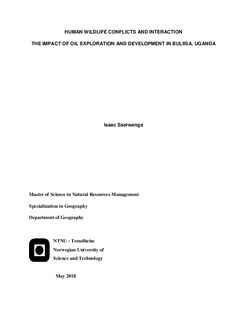| dc.description.abstract | After discovery of an estimated 2.5 billion of commercially viable oil, worth $2 billion in annual revenue for 20 years in the Albertine graben, Uganda’s pursuit for a middle state income status seemed attainable. However, the oil reserves are situated in biodiversity sensitive area, with endemic, and vulnerable species. Development of petroleum resources may thus have detrimental environmental impacts.
This study seeks to explore the relationship between oil exploration and development activities with human wildlife conflicts and interaction in Buliisa.
Due to unequal power relations between non-place based and place-based actors in wildlife conservation, political ecology was used to show how benefits are used to offset costs or sustain the socioeconomic inequalities between actors. Overtime, the state has continued to foster its preservationist and a quasi-conservationists agenda where local people have emerged losers because of the recurring challenge of aligning benefits with costs incurred.
These costs to local people are sustained by interaction between humans and wildlife with inevitably competing interests. Agricultural production close to the park boundaries acts as a pull factor for interaction and conflicts It’s difficult to avoid foraging of crop and threats to human life from wild pigs, baboons, buffaloes, elephants, and other wildlife from Murchison Falls National Park.
Since 2006 the inception of exploratory drilling in or proximate to sensitive areas, the animals have increased their avoidance range away from oil exploration activities. Overtime human wildlife interactions have recurred in areas close to the park leading to conflicts between local people and park management.
The thesis provides a spatial presentation of human wildlife incidents and areas of susceptibility to conflicts. The study finds that there are relationships between incidents and distances from houses, park boundary, and drill sites. This indicates the existence of an association between oil exploration and development with human wildlife incidents occurring in communities close to the Murchison Falls National Park. | nb_NO |
